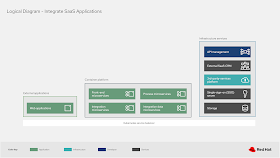 |
| Part 3 - Example CRM integration |
The foundation for this logical diagram was researching a use case where customers were successful with a portfolio solution.
It's a starting point for the generic architecture that rises from several customer solution that were researched.
Having completed the outline of the architectural details and the resulting logical diagram elements, it's now time to take a look as specific examples.
In this article you'll walk through a specific example where organizations are looking at integrating with external customer relationship management (CRM) applications. This is done to leverage pushing and pulling information from their organization to and from the CRM application.
Architecture scenarios
As a reminder, the architectural details covered here are base on real customer integration solutions using open source technologies.The example scenario presented here is a generic common architecture that was uncovered researching customer solutions. It's my intent to provide an architecture that provides guidance and not deep technical details.
This section covers the visual representations as presented. There are many ways to represent each element in this architecture, but I've chosen icons, text and colors that I hope are going to make it all easy to absorb. Feel free to post comments at the bottom of this post, or contact me directly with your feedback.
Now let's take a look at the details in this architecture and outline the solution.
Integrating with CRM applications
The example architecture shown in figure titled Example: External CRM Integration outlines how to integrate an external SaaS CRM application in to your architecture. Note that this diagram is focusing narrowly on the aspects related to integrating with an external SaaS CRM application, therefore it's detailing a small set of integration components.In this example, starting from the top left corner, the web application is the entry point for users and can be more than just a web application. It represents everything from partners, customers, to internal employee interfacing as an entry point with the organizations architecture.
This connects to your services through an API gateway. It's leveraging a group of frontend microservices that provide needed functionality, everything from simple to the complex activities that front end application need to service their clients.
Frontend microservices are also gathering data and information from the various organizational backend systems by working through integration microservices. There is a conscience effort here to keep this example as concise as possible, therefore the integration of various potential back-end systems has been simplified to just the external SaaS CRM application.
When interaction with organizational processes is desired, you can leverage the process microservices that expose process automation functionality. These in turn make use of the integration microservices for interacting with the external SaaS CRM application.
For completeness, the single-sign-on (SSO) server and its integration with the organizations active directory server is shown. This represents the pervasive nature of security as all microservices should have an SSO plugin assisting with authentication and authorization tasks.
What's next
An overview of the series on integrating SaaS applications portfolio architecture can be found here:
Next in this series, taking a look at more details when connecting to external SaaS CRM applications using a specific connector.
- An introduction
- Common architectural elements
- Example CRM integration
- Example CRM connector integration
- Example 3rd-party platform integration
- Example processes and 3rd-party platform integration
Next in this series, taking a look at more details when connecting to external SaaS CRM applications using a specific connector.
